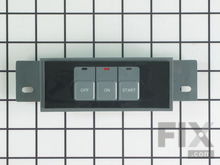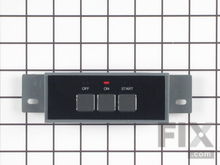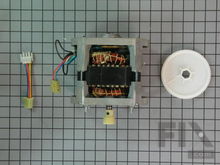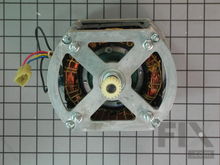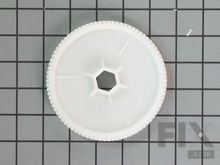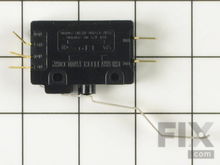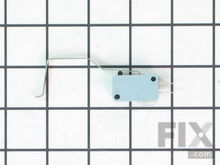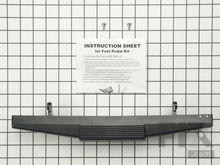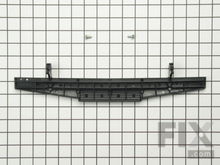How To Repair Your Trash Compactor When It Will Not Start
- Rated as REALLY EASY
- 29 repair stories
- 4 step by step videos
Start Switch
If your trash compactor won’t start, the problem may be with the start switch. The start switch is used to supply power to the motor to initiate the compaction cycle. The switch may be a rotary switch, pushbutton switch or rocker style switch and located either on the control panel. Or it may be located inside the drawer opening on foot pedal operated models. The switch uses momentary contacts that close to start the motor and then revert back to open contacts. If the contacts burn out or become corroded, they may not provide continuity and the motor will not start. You can check the start switch for continuity with a multi-meter. To determine if you have a defective switch, first locate the fuse or breaker and turn off the power. If your model uses a control panel mounted start or run switch, remove or lower the panel to expose the rear of the switches. Some models will require removal from the cabinets to access the control panel. If your model uses a foot pedal operated switch, you will need to remove the drawer from the unit to access the start switch and the actuator. Verify that the foot pedal contacts the switch actuator properly. Using the wiring diagram for your model, determine the switch terminals to test and then remove the wires from the terminals, usually marked C and NO. In the normal or resting position the switch should show no continuity. When the start knob is rotated or the push button is depressed to the start or run position, the switch should then show continuity. If there is no continuity when activated, the switch needs to be replaced.
Drive Motor
If your trash compactor won’t start, you may have a defective drive motor. The start or run switch is used to supply power to the motor to initiate the compaction cycle. If the windings in the motor are open or if the motor centrifugal switch is open, then the unit will not start. To check for a defective motor you will need to remove the unit from the cabinets and disconnect the power. Remove the bottom or back panel to access the motor wire harness connections and then remove the wires from the motor terminals. Make sure that you record where the wires are attached first. Using the wiring diagram for your model, locate the terminals for the motor windings and the internal centrifugal switch. With a multi-meter, test the motor windings and the centrifugal switch for continuity. The motor windings should normally show a few ohms of resistance while the centrifugal switch should be near zero ohms. If you do not get these readings, the motor is most likely defective and will need to be replaced. Check all of the wire terminals for any signs of corrosion or poor connections as well.
Directional Switch
If your trash compactor won’t start, the problem may be a defective directional switch. The start or run switch is used to supply power, through some contacts in the directional switch, to the motor start windings. If the directional switch contacts are open circuit then the unit will not start. The directional switch is located at the top of the compactor and is activated by a metal tab on the ram that contacts the actuator lever of the switch. You can check the directional switch for continuity with a multi-meter. Start by removing the compactor from the cabinets and disconnecting the power. Remove the mounting brackets and the top cover to access the location of directional switch. Remove the ram taking care not to damage the directional switch actuation lever. Remove the switch for better access and then remove the wires from the switch. Take note of the location of each wire. Using the wiring diagram for your model, locate the appropriate switch terminals to check. Most directional switches incorporate the top limit switch as well. Look for the section of the switch that has three terminals marked C for common, NO for normally open and NC for normally closed. With the wires removed you should check the common and normally closed terminals for continuity. If there is no continuity then the switch is defective. Depress the switch lever and check the common and normally open terminals. If there is no continuity then the switch is defective. Replace any defective switch and verify that the actuating tab on the ram contacts the switch lever properly. Check all of the wire terminals for any signs of corrosion or poor connections as well.
Foot Pedal
If your trash compactor won’t always start, the problem may be with the foot pedal. Some models use the foot pedal to open the drawer as well as to activate the start switch. The foot pedal on most trash compactors is secured to the frame of the drawer with shoulder screws so that it can pivot easily. If the foot pedal becomes damaged or broken, it may not contact the start switch properly and the unit may not start. To inspect the foot pedal, you will need to pull the drawer out far enough to access the mounting screws on the sides. Check the foot pedal for signs of damage and the mounting screws to ensure that they tighten properly and replace if necessary. Check the actuator lever to ensure that it makes proper contact with the switch as well.
More Repair Parts
Still not sure which part is broken? We can offer you custom troubleshooting help if you search with your model number.






